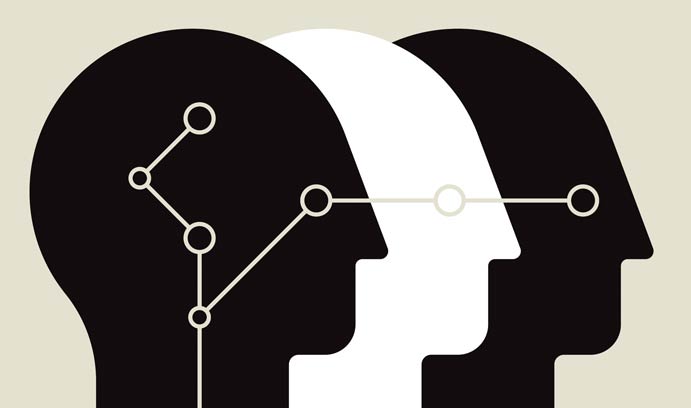The Convergence of Man and Machine
Nano Human Interfaces Initiative
Lehigh is making a $3-million institutional investment in a multidisciplinary research initiative that promises to change the way human beings harness and interact with data and with the sophisticated instruments of scientific discovery.
The Nano/Human Interface Presidential Engineering Research Initiative proposes to develop a human-machine interface that will improve the ability of scientists to visualize and interpret the vast amounts of data—often in the terabytes, or trillions of bytes—that are generated by scientific research.
The leader of the initiative is Martin P. Harmer, professor of materials science and engineering. Other senior faculty leaders include Jeffrey M. Rickman, professor of materials science and engineering and also of physics; Anand Jagota, department chair of bioengineering; Daniel P. Lopresti, department chair of computer science and engineering and director of the Data X Initiative; and Kate Arrington, associate professor of psychology.
The initiative was approved by Lehigh President John D. Simon and Provost Patrick V. Farrell.
“With this initiative,” the group wrote in its proposal, “we are poised to lead the next revolution in the conduct of science, namely drawing inferences from vast datasets whether experimentally or computationally generated.
“The development of this human-machine element will require a partnership with behavioral psychologists and graphic designers, who understand the most effective, visual human learning strategies.”
The Lehigh initiative aligns with two of the six “big ideas” for research identified by the National Science Foundation in the next decade. These ideas are “Work at the Human-Technology Frontier” and “Harnessing Data for 21st-century Science and Engineering.”
Electron microscopes, spectroscopes and other tools that characterize the properties of materials, including computers that simulate materials’ behavior, generate terabytes of data, the group said. To be useful, this data needs to be coupled with analytical tools that organize and display it in a way humans can comprehend and interpret. Instead, much of the data is under-utilized or discarded.
The group is working with Library and Technology Services (LTS) to create a network of spaces on campus where researchers will work interactively with an artificial intelligence tool called Buddy. Buddy will assist researchers by learning from the data it acquires, much as online retailers learn to anticipate the preferences and likely actions of consumers browsing websites.
“We will talk to Buddy like we talk to our phones,” said Harmer. “Buddy will remember what it has done before and will learn from its interactions with us. It will learn what we’re interested in, anticipate what we want to do and give us a potential solution.”
This ability to “interrogate” data, said the group, will enable researchers to determine, in real time, the significance of their results and to know which additional data, and how much, is needed to solve a problem.
“Our proposed active learning approach will constitute an artificial neural network to permit acquisition tools to learn in real time…[and to] reduce the complexity of a problem,” the group wrote.
The group cited two areas of research where progress has been slowed by the inability to fully visualize and interpret vast amounts of data. These are the production of nanomaterials and the development of medical uses for carbon nanotubes (CNTs) wrapped with single strands of DNA.
“Nanomaterials have been studied for decades and continue to outperform conventional materials in research labs,” the group wrote. “The critical challenge is to scale up nanomaterials to industrial parts. To accomplish this, scientists and engineers need to characterize and manipulate tens of thousands of nanoscale interfaces.
“While current characterization tools are highly advanced, they produce vast amounts of [data] where meaningful information is obscured. We need an analytical toolbox that can identify emerging patterns in this data and permit visual interaction in a comprehensive, informative and intuitive way.”
The group noted that DNA-wrapped CNTs are being developed for medical imaging and sensing and for drug delivery, and that the functionality of these hybrids depends on their structure and, ultimately, on the sequence of the DNA.
“The space of DNA sequences is vast and the search for ordered hybrids involves sifting through massive data streams both from computer simulation and optical spectroscopy,” the group wrote. “We need the ability to analyze and identify a small number of functional hybrids (in the hundreds) from among the [trillions of] possibilities.”
The initiative has two external advisers. Uma Chowdhry is Chief Science and Technology Officer emeritus at DuPont. Alton D. Romig Jr. ’73 ’75 M.S. ’77 Ph.D. is Executive Officer of the National Academy of Engineering, former Vice President and General Manager of Lockheed Martin Aeronautics Company Advanced Development Programs (also called Skunk Works) and former Executive Vice President of Sandia National Laboratories.
The group is planning to host an international workshop next year. Ohio State University and the Army Research Laboratory have expressed a high level of interest in partnering with the Nano/Human Interface researchers.
To learn more about the initiative, go to go.lehigh.edu/nanohuman
Posted on:



